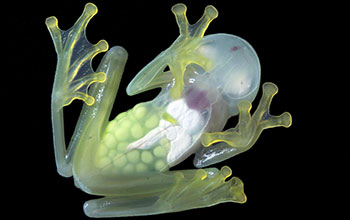Multimedia Gallery
Glassfrog with completely transparent belly
This species of glassfrog (Hyalinobatrachium colymbiphyllum) has a completely transparent belly, making its red heart and--for pregnant females--eggs visible.
More about this image
In tropical rainforests, the eggs of glassfrogs are laid on leaves hanging over streams where, until they hatch and drop into the water below to begin life as tadpoles, they are a tasty snack for snakes, insects and other predators. It is during this vulnerable stage that biologists believed the eggs of most species were on their own, with no parental help. Researchers knew that with a few species, fathers were known to care for their developing embryos, but researchers thought this paternal devotion had evolved from ancestors entirely lacking parental care.
However, while walking along a stream in Panama late one night, Jesse Delia, a Ph.D. student in the lab of Karen Warkentin, a Boston University (BU) professor of biology, spotted a glassfrog mother sitting on her clutch of eggs. With research partner Laura Bravo Valencia, a graduate student at the Universidad de los Andes in Bogotá, Colombia, Delia went on to observe nighttime parental behavior among no fewer than 40 species of glassfrogs.
For the study, Delia and Bravo Valencia spent six rainy seasons at 22 sites along streams in Colombia, Ecuador, Mexico, Panama and Peru where they performed field monitoring of parental behavior throughout the duration of embryonic development for 13 species.
Delia and Bravo Valencia discovered that in many species, glassfrog mothers brood their eggs during the night the eggs are fertilized, and that this care improves the survival of the eggs. They also found that in almost a third of the species, glassfrog fathers stay on guard for much longer periods. In fact they found parental care in every glassfrog species they sampled.
An analysis of glassfrog evolutionary history that took into account the new field data collected by the investigators discovered that male parental care probably evolved from female care and that "parental care gets elaborate when males take over," Warkentin says. [Research was funded in part by the National Science Foundation (grant IOS 1501531).]
To learn more about this research, see the BU news story Glassfrogs show surprising diversity of parental strategies. (Date image taken: March 2017; date originally posted to NSF Multimedia Gallery: June 27, 2017)
Credit: Jesse Delia, Department of Biology, Boston University
See other images like this on your iPhone or iPad download NSF Science Zone on the Apple App Store.
Images and other media in the National Science Foundation Multimedia Gallery are available for use in print and electronic material by NSF employees, members of the media, university staff, teachers and the general public. All media in the gallery are intended for personal, educational and nonprofit/non-commercial use only.
Images credited to the National Science Foundation, a federal agency, are in the public domain. The images were created by employees of the United States Government as part of their official duties or prepared by contractors as "works for hire" for NSF. You may freely use NSF-credited images and, at your discretion, credit NSF with a "Courtesy: National Science Foundation" notation.
Additional information about general usage can be found in Conditions.
Also Available:
Download the high-resolution JPG version of the image. (3.2 MB)
Use your mouse to right-click (Mac users may need to Ctrl-click) the link above and choose the option that will save the file or target to your computer.



 All images in this series
All images in this series